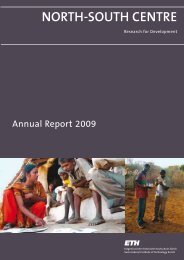Annual Report 2006/07 - ETH - North-South Centre North-South ...
Annual Report 2006/07 - ETH - North-South Centre North-South ...
Annual Report 2006/07 - ETH - North-South Centre North-South ...
Create successful ePaper yourself
Turn your PDF publications into a flip-book with our unique Google optimized e-Paper software.
Research Fellow Partnership Programme (RFPP)Research fellowsLanto Herilala Andriambelo, ESSA, Madagascar /Clémence Dirac, <strong>ETH</strong> ZurichSupervisorsJean-Pierre Sorg, <strong>ETH</strong> Zurich / A. Buttler, EPFL /G. Rajoelison, ESSA, MadagascarCollaboratorsR. Solomampionona, CFPF, Morondava, Madagascar /B. Campbell, CIFOR, Indonesia / S. Razanaka, CNRE,Antananarivo, Madagascar / R. Steppacher, IUED, Geneva, /L. Rakotomalala, SAHA Menabe, Morondava, Madagascar /E. Hertz, Univ. de NeuchâtelDurationNovember 2005 – October 2008Enhancing the livelihood of the local population ina biodiversity hotspot in Madagascar: Scientific bases fora participatory forest landscape managementThe overall aim of this project is to set up scientific bases fora multifunctional and sustainable management of a forestlandscape in Central Menabe, Madagascar. Following thisgoal, the specific objectives are (i) to assess the role of forestproducts and local knowledge about forest and tree managementin the livelihood strategies, (ii) to determine productionpotential and regeneration capacity of the mostimportant forest products that support livelihoods, and (iii)to deduce potentialities and constraints for sustainablemanagement of the forest landscape.Preparatory work concluded with one paper accepted forpublication. Field work for this project started in March <strong>2006</strong>.The project benefits from a multidisciplinary research group(students, supervisors and collaborators from social and naturalsciences) that allows the exchange of scientific informationabout participative and biological methods of datacollection.After the presentation of the project to collaborators, villagersand other local associations involved in the humanforestinterface, socio-demographic data were gathered inthe six main villages surrounding the Kirindy forest (a placewell-known to researchers interested in dense dry tropicalforests) with the aim of selecting five of the six villages asresearch sites. However, as the conditions for forest use andpopulation pressure on forests differ in each village, all sixvillages were kept as research sites.After the selection of the research sites, data concerning differentaspects of the human-forest interface (markets, agricultureand livestock, wood and non-wood products used byvillagers, payments for ecological services) were collected.Data were gathered using semi-structured interviews, questionnaires,scoring exercises and mapping.The objectives for the second project year will consist ofanalyses and a second period of field work.Students conducting informal interviews while sharing coconuts with villagers54
















